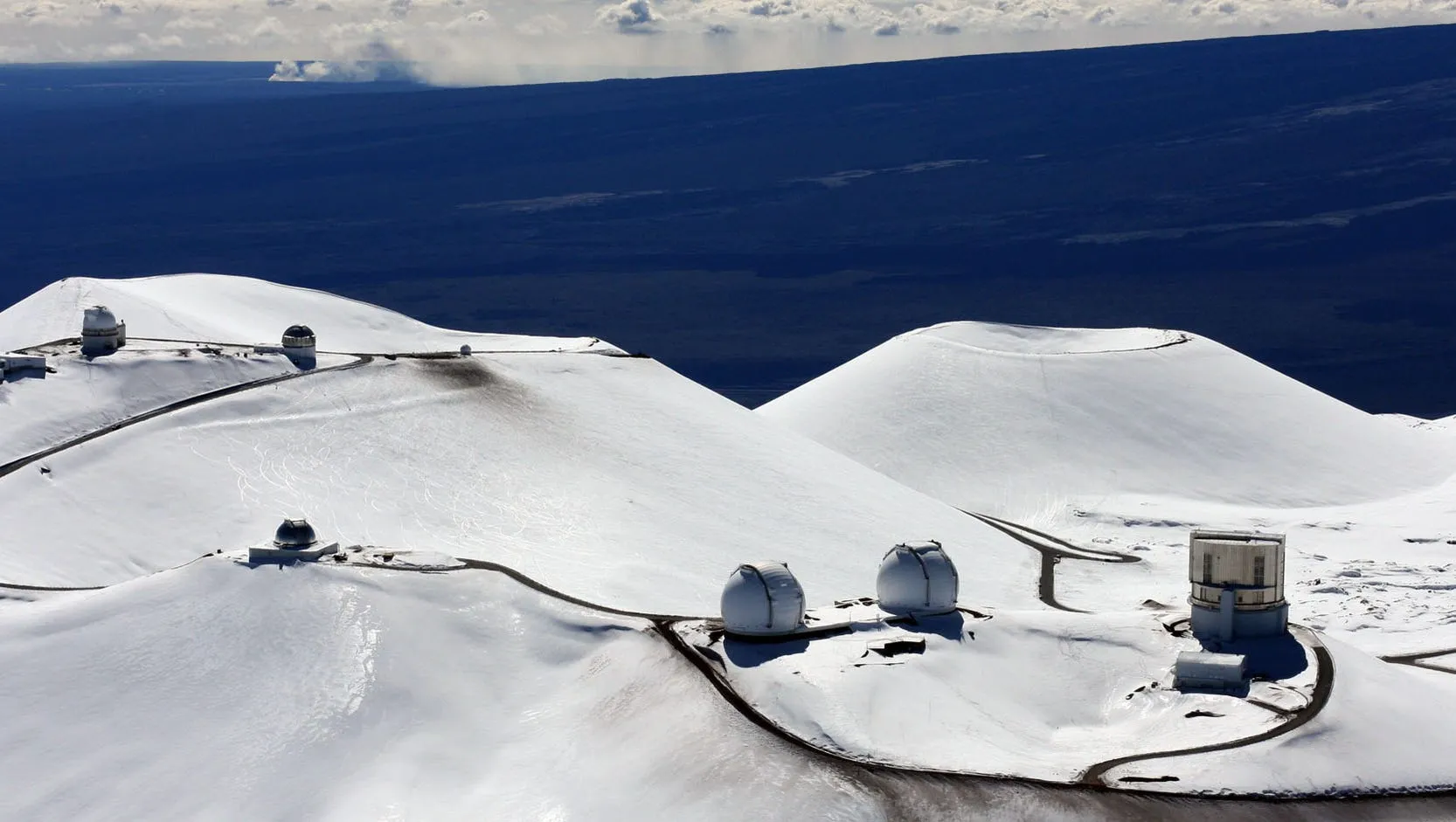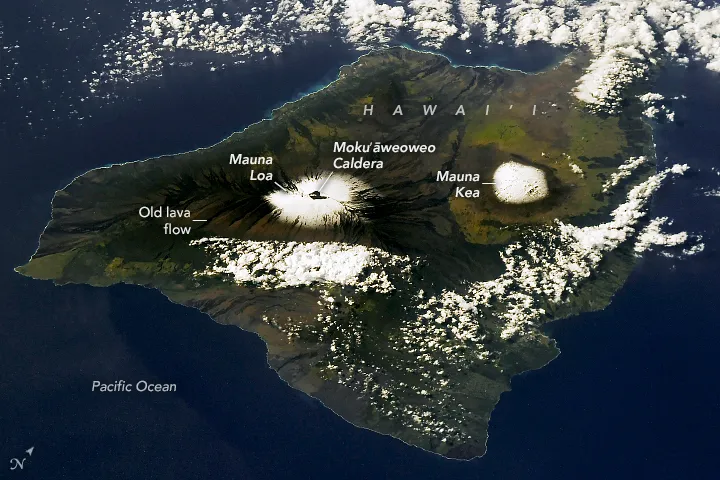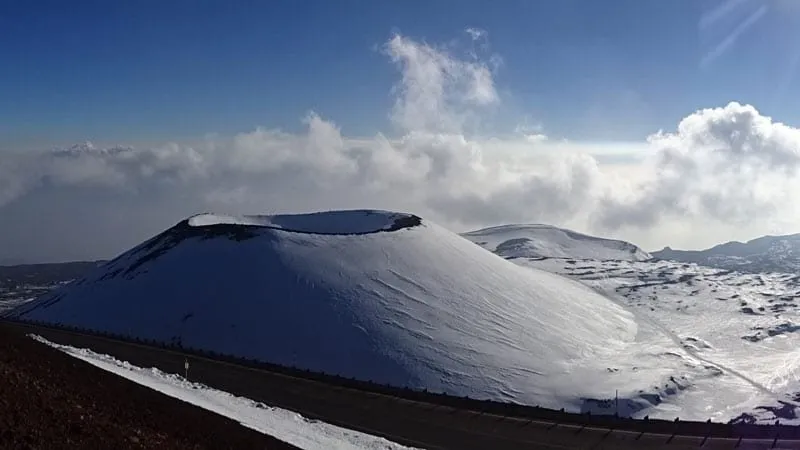Table of Contents
When many people think of Hawaii, they picture golden beaches, palm-trees, tropical surf and sun-drenched rainforests. But perched high above the tropical zone are some of the most surprising sights in the islands: snow-capped volcanoes. On Hawaii’s tallest peaks, the combination of elevation, cold air and storms can turn what seems like a perpetual summer paradise into a snow-covered landscape. In this post I’ll explore the volcanoes in Hawaii that actually get snow, how and when it happens, and what it means for visitors and the environment.
The Main Players: Mauna Kea & Mauna Loa
Mauna Kea (13,803 ft) & Mauna Loa (13,679 ft)
Towering 13,803 feet above sea level, Mauna Kea is not only the tallest volcano in Hawaiʻi — it’s the tallest mountain in the Pacific. Its name literally means “white mountain” in Hawaiian, a nod to the snow that graces its summit several times each winter.
Snow on Mauna Kea usually appears between December and February, when cold air from passing winter storms meets the moist atmosphere over the Big Island. At this elevation, temperatures regularly drop below freezing, turning rain into snow and transforming the volcanic slopes into a dazzling winter landscape.
When conditions are right, the contrast is stunning — a white-capped mountain rising above the palm trees and lava fields below. Even though the snow might only last a few days before melting, it’s a breathtaking reminder of the island’s extreme elevation changes.
The Mauna Kea Access Road often closes during heavy snowfall due to icy conditions, so anyone hoping to visit should always check local updates before attempting the drive. And if you make it to the top, dress warmly — temperatures can easily dip below freezing, even while it’s 80°F on the beaches below.

Just south of Mauna Kea sits Mauna Loa, the largest volcano on Earth by volume. Standing at 13,679 feet, its massive shield shape dominates more than half of the Big Island. Like its neighbor, Mauna Loa also receives occasional snowfall, particularly during strong winter storms that sweep across the Pacific.
The snow usually blankets the upper slopes for a short time, creating a surreal view of white streaks running across the dark volcanic rock. It doesn’t last long — the sun at this elevation is intense — but for a day or two, Hawaiʻi’s largest volcano looks like a snow-covered mountain straight out of a postcard.
Mauna Loa’s immense size and gradual slopes make it less accessible to casual visitors than Mauna Kea, but those who catch a glimpse of it under snow often describe it as one of the most awe-inspiring sights in the islands. Seeing snow on an active volcano that erupted as recently as 2022 feels like watching fire and ice coexist in perfect harmony.

A Third Volcano: Haleakalā
Haleakalā (10,023 ft) – Maui
On Maui, the massive Haleakalā volcano rises more than 10,000 feet into the sky and forms much of the island’s eastern half. While it’s best known for its breathtaking sunrises / sunsets, dreamy stargazing and vast crater views, Haleakalā occasionally receives its own dusting of snow.
Snowfall here is much rarer and usually lighter than on the Big Island’s peaks, but when it happens, the scene is unforgettable — a white cap crowning the island’s tallest summit, visible all the way from the beaches of Kihei or Wailea.
When a cold winter storm passes through the islands, freezing temperatures can drop low enough to create a thin layer of snow or ice near the summit. On rare occasions, even lower elevations on Maui, such as Polipoli State Park, have experienced snow — a remarkable event considering Hawaiʻi’s tropical latitude.
If you’re visiting Maui in winter, keep your eyes on the summit of Haleakalā after a big storm. You might just spot one of nature’s most unexpected Hawaiian wonders.

Why Snow in Tropical Hawaiʻi?
It all comes down to altitude and atmosphere. Hawaiʻi’s tallest volcanoes rise well above 10,000 feet, reaching the cold, thin air of the upper troposphere. Even though the islands sit near the equator, the temperature at those heights can easily fall below freezing.
When moist air from Pacific storms climbs up the slopes of these volcanoes, it cools rapidly — and under the right conditions, the moisture turns into snow rather than rain. This process is most common in winter, when Kona storms bring cooler air and heavy precipitation to the islands.
As a result, Hawaiʻi can have both tropical beaches and snow-capped peaks — sometimes on the same day.
Tips for Visitors
- If you plan to see snow on one of these volcano summits, aim for winter months (late fall through early spring) when the combination of cold air and rain/storms are more likely.
- Bring warm clothing — just because you’re in Hawaiʻi does not mean it’s tropical up there. At 13,000+ ft in freezing air you’ll need layers, gloves, hat, etc. Especially when there is crazy wind chills.
- Check road conditions and weather forecasts. Some roads to these summits may close or become icy. For example, access to the summit of Mauna Kea is sometimes restricted due to snow/ice. (Uprooted Traveler)
- Respect access rules and cultural sites. On Mauna Kea especially, the summit has significant cultural and ecological importance.
- Photography opportunities are unique: snow-on-volcano in Hawaiʻi is unlike many places. You get tropical surroundings in the lowlands and wintry conditions at high altitude.
- If you’re on Maui and hope to see snow on Haleakalā, remember it is less common — you may only get a dusting, if any.
Don’t base your entire trip on snow there unless you’re flexible.
Snowfall on Hawaiʻi’s volcanoes is one of those delightful paradoxes that reminds us just how varied Earth’s climates can be. The same islands that host surfers and sun-seekers also host peaks that look like they belong in the Rockies or Alps—blanketed in white after high-altitude storms. Whether you go to Mauna Kea or Mauna Loa on the Big Island, or you’re visiting Maui and glance up at Haleakalā on a crisp morning, seeing snow in Hawaiʻi is a memorable experience.
It underscores how elevation and geography can override the usual “tropical island” expectation. For both adventurers and those seeking nature’s surprises, these volcano summits provide a rare glimpse into a colder world, right next to palm-fringed beaches.
Further Reading & Links
- Does it Snow in Hawaiʻi? (SeaParadise) – https://www.seaparadise.com/does-it-snow-in-hawaii-where-and-how-often/ (Sea Paradise)
- Snow in Hawai’i (Lyman Museum) – https://lymanmuseum.org/exhibits/archive-special-exhibits/snow-in-hawaii/ (lymanmuseum.org)
- Volcano Watch: Ice & Snow on Hawaii’s Volcanoes (USGS) – https://www.usgs.gov/news/volcano-watch-frozen-time-ice-and-snow-yield-secrets-past (USGS)
How rare is snow in Hawaii? (Newsweek) – https://www.newsweek.com/how-rare-hawaii-snow-records-1976758 (Newsweek)
Frequently Asked Questions
1. Does it really snow in Hawaii, or is that just a myth?
Yes — it really snows in Hawaii! Even though most visitors imagine warm beaches and palm trees, Hawaii’s tallest volcanoes rise above 10,000–13,000 feet, high into the freezing upper atmosphere. When winter storms pass over the islands, rain can turn into snow at these elevations, creating incredible snow-capped peaks above the tropical landscape.
2. Which volcanoes in Hawaii get snow the most?
The two volcanoes that regularly get snow are Mauna Kea (13,803 ft) and Mauna Loa (13,679 ft) on the Big Island. These massive mountains reach cold, thin air where winter storms can blanket their upper slopes in white several times each year. Snow typically appears between December and February, but it can occur anytime during winter storm season.
3. Why does Mauna Kea get so much snow compared to other Hawaiian mountains?
Mauna Kea is the tallest mountain in the Pacific and rises nearly 14,000 feet above sea level. At that height, temperatures regularly fall below freezing, especially during passing winter storms. When moist air cools rapidly over the summit, it transforms into snow. This is why the mountain’s name in Hawaiian — Mauna Kea, or “white mountain” — reflects its snowy summit.
4. Does Mauna Loa also get snow like Mauna Kea?
Yes, although Mauna Loa gets snow less frequently. It’s still extremely tall and can receive snow during powerful winter storms. The snow usually blankets its upper slopes for a short time, creating white streaks across the dark volcanic rock. Because the mountain is so massive and broad, the snow melts quickly under the intense sun — but when it happens, it’s an unforgettable sight.
5. Can Haleakalā on Maui get snow too?
Yes — but only rarely. At 10,023 feet, Haleakalā on Maui is tall enough for occasional dustings of snow or ice during cold winter storms. These events are uncommon but spectacular, especially when a thin layer of white caps the summit and can be seen from Kihei, Wailea, or even central Maui. Sometimes even lower elevations like Polipoli State Park have seen snow, which is extremely rare in the tropics.
6. Why does snow fall in a tropical place like Hawaii?
It’s all about elevation and atmospheric conditions. Hawaii’s tallest volcanoes reach high into cold upper air, where temperatures can sink below freezing even though the islands sit near the equator. When Pacific moisture rises up their slopes and cools rapidly, it turns into snow instead of rain. Winter storms — especially Kona storms — bring the freezing air needed for snowfall.
7. When is the best time of year to see snow on Hawaii’s volcanoes?
Your best chance is during late fall through early spring, especially December to February when winter storms are most active. Snow doesn’t happen every week, but when storms line up correctly, both Mauna Kea and Mauna Loa can become snow-capped for a few days.
8. Is it safe to drive to the summit of Mauna Kea during snowfall?
It depends on the conditions. The Mauna Kea Access Road often closes during or after snow due to ice, strong winds, or limited visibility. Always check official road updates before driving. Even when the road is open, prepare for freezing temperatures, strong winds, and rapidly changing weather — very different from the beaches below.
9. What should I wear if I’m visiting a snowy volcano in Hawaii?
Visitors should dress for full winter conditions. At 13,000+ feet, it can be below freezing, extremely windy, and icy. Bring:
- Warm layers
- Winter jacket
- Gloves
- Hat
- Closed-toe shoes or boots
Even if it’s 80°F at sea level, it can feel like the Rockies or the Alps at the summit.
10. Is it worth visiting Mauna Kea or Mauna Loa just to see snow?
Absolutely — but with realistic expectations. Snow doesn’t happen daily, and it may melt quickly. However, when it does appear, the contrast of snow on volcanic slopes above palm trees and beaches is one of the most unique sights in the world. Visitors often describe it as surreal and unforgettable.
11. How rare is it to see snow on Haleakalā compared to the Big Island summits?
Snow on Haleakalā is much rarer than on Mauna Kea or Mauna Loa. Even when it does snow, it’s typically a very thin layer that melts quickly. Your chances improve after strong winter storms, but it’s not guaranteed — so it’s best to treat any Haleakalā snowfall as a lucky bonus rather than a planned event.
12. Are there any cultural or environmental rules to follow when visiting snowy summits?
Yes. Especially on Mauna Kea, the summit holds deep cultural significance for Native Hawaiians and is also home to fragile ecosystems. Always respect restricted areas, stay on designated paths, avoid disturbing observatory zones, and follow all posted guidelines. Snow or no snow, the summit is a sacred place deserving of respect.
13. Are the photo opportunities really that special when it snows in Hawaii?
Without a doubt. Few places on Earth offer such dramatic contrasts: snow-capped volcanoes rising above tropical coastlines, palm trees, and volcanic plains. Photographers cherish these rare moments, especially right after a storm when snow is fresh and sunlight hits the peaks.
14. Should I plan my Hawaii vacation around seeing snow on volcanoes?
Not necessarily. Snowfall is unpredictable and weather-dependent. If you’re flexible and visiting in winter, you might get lucky — especially on the Big Island. But it’s better to treat snow as a surprise bonus rather than the main goal of your trip. Hawaii has far more reliable experiences to plan around, like beaches, hiking, stargazing, and culture.
If you would like to read and learn more about interesting things in Hawaii! Check out our blog page here on our website!
or
